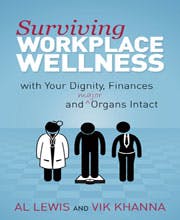Is Workplace Wellness A Bad Idea?
Workplace wellness is one of the worst ideas since New Coke—and nowhere near as good for you.
So writes Vik Khanna and Al Lewis, authors of the new book “Surviving Workplace Wellness: With Your (Major) Organs, Dignity and Finances Intact?”
The authors have a lot to say about the welllness field, and do so in an humorous manner, as they have been in the field for years. While Khanna has over 25 years as a health consultant with private industry, government, unions and consumer groups, Lewis is credited with inventing wellness’s cousin, disease management.
Both believe that employers are being sent down the wrong path when it comes to wellness programs.
Back to New Coke. “I ran a company for years, and, speaking of Coke, knowing what I know now, I’d way rather give all my employees a Coke than institute a conventional workplace wellness program,” writes Lewis. “First, it’s much cheaper. Second, most people like the taste. Third, unless it is dropped from an airplane onto someone’s head, one can of Coke isn’t going to kill anybody. As we’ll see, the same cannot be said, statistically speaking, for wellness programs."
Lewis argues that “conventional wellness is hazardous to your health.” Challenging one of the foundations of the wellness programs, the author point out there are harms to screening:
- Failing to diagnose a real problem, which may encourage someone to ignore symptoms which may emerge later, or mislead them into believing that their “negative” result gives them permission to persist in or revert to unhealthy behaviors ;
- Detecting problems (usually cancers) for which early diagnosis and treatment not only don’t change the end result, but also make people feel worse for longer ;
- Diagnosing problems that would not have become clinically significant or don’t actually exist, the follow-up for which can be hazardous, debilitating, and expensive.
And the authors point out there is harm to the bottom line.
It’s also hazardous to the health of your bank account. You might think, “At least my employer is paying for this program. It’s not coming out of my skin because I’m participating to avoid the forfeiture—albeit against my better judgment.” But it’s still your nickel for two reasons. First, as we’ll see, if you actually do everything your employer’s wellness vendor insists upon, your out-of-pocket healthcare expense will likely rise for the simple reason that some wellness findings and recommendations will push you to get even more medical testing for which you’ll need to pony up the co-pay. Worse, you may end up paying the full freight for the additional testing if you have not yet met your annual deductible.
Your employer’s healthcare spending will rise as well…and that hits you, too. Why? Because your employer doesn’t finance these programs by asking the shareholders to pretty please accept a dividend reduction so you can be given unnecessary medical tests. Instead, your company has a budget for “employee compensation,” phrased in the form of this equation:
Your Total Compensation = Your Paycheck + Your Benefits
The most expensive benefit—and also historically the fastest-growing—is healthcare. You have, no doubt, heard how paychecks for most people, possibly including you, have “stagnated.” But total compensation is far from stagnant—mostly because of the increase in health benefits. (These days, it’s popular to simply make you pick up more of the tab directly for your own healthcare expenses. In that case, your paycheck could rise, but so will your health expenses.)
What Companies Can Do
“The problem with the current wellness program models is that employers are under the impression that the impact of these programs is clearly defined and measurable, “says Khanna. “That’s not the case. So we tell companies to focus on offering voluntary programs to encourage healthy choices and create a happier work environment. Give everyone an option to have a stand-up workstation, deliver healthy snacks directly to employee’s workstations free of charge.”
The authors suggest some other specific of addressing medical costs and concerns:
What if your company redirected its existing financial forfeiture structure into initiatives consistent with the medical literature’s conclusions that we are the most over-doctored society ever? Perhaps your HR department could say: “Here, you can shave some money off your co-pay if you simply agree to learn about the pluses and minuses of medical interventions before you proceed with them.” And, then they offered you an app with some reading, an (ungraded) quiz on that reading, and a few questions to ask your doctor. You could also call an expert in that field if you wanted more information. To top it off, just for getting educated, you could earn a reduction in your co-pay if you still want to go through with the intervention in question, however shaky its basis in evidence.
Your company would also save money (and while I doubt that’s a major concern of yours, your boss might be reading this book too), because some people, like me, simply wouldn’t submit to (for example) Chapter 4’s sinus scans if they knew how much radiation and intravenous dye was introduced into their body, vs. the likely diagnostic benefit. And, recall the compensation equation from the introduction: a portion of the savings from inappropriate care avoidance directly or indirectly accrues to you.
Likewise, what if your company offered you the opportunity to go to the best hospitals in the country completely free (and paid travel expenses for you and a companion) when you had a really serious problem? This is a benefit that you’d expect to find at Google or Facebook but instead you find at Walmart or PepsiCo, because it’s not so much about making you happy with your care as it is about saving money by making you happy with your care.
As insiders in this field the authors felt it was time to speak up. “It is true that there has been no controversy until recently. Most people have just accepted these pry-poke-and-prod indignities as part of their job. But it’s more than indignity and inconvenience. You are being ripped off, misled, and even harmed as a result of these programs, and this book should galvanize you and your colleagues to revolt against these programs.”

